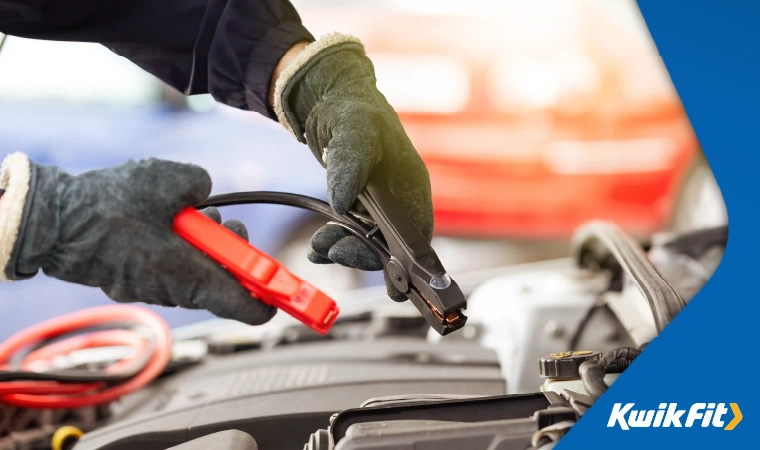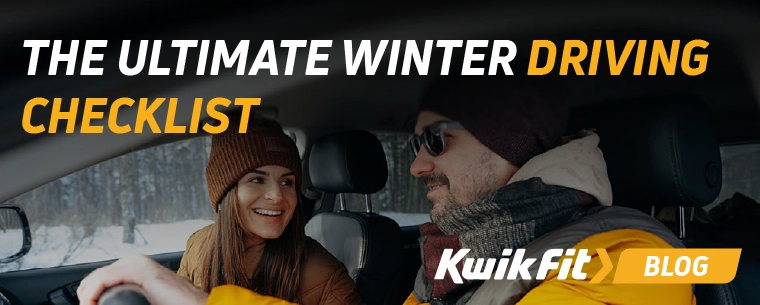How to Start a Car with a Dead Battery
Jack Dreyer | Wednesday 13th March 2024 10:00am

There are few ways to ruin a morning more quickly than getting into your car and finding out that the battery’s dead. It seems like such a small component, but makes a world of difference when it’s not working.
If you’re just looking for information on how to jump start your car, head down to ‘Jump Starting with Jump Leads’ for instructions – but if you want to understand why car batteries go flat and how to prevent that from happening, read on.
How to Jump Start Your Car

The most common and easiest way to jumpstart a car is with jump leads and another vehicle that has a fully charged battery. Before you do anything, quickly check that the battery isn’t damaged or leaking any liquid, and that the key is out of the ignition of both cars.
Make sure that you’re not wearing any jewellery while doing this – and don’t attempt to jump start the car if the battery is leaking or if it’s frozen. Doing so can cause the battery to explode. Likewise, be very careful not to touch any metal to the terminals.
Step 1: Position both cars relatively close together so they’re facing bonnet to bonnet but not touching. Leave enough space so you can comfortably fit between the cars. The jump leads should be able to reach both batteries easily without too much tension. If the leads are too taut, move one car slightly closer.
Step 2: Double check that both cars are in neutral with the handbrakes on.
Step 3: You should have two jump leads - one black and one red. First attach the red lead to the positive terminal of the flat battery. Then attach the other end to the positive terminal of the car with a charged battery. Be careful not to touch any metal in the engine bay while doing this.
Step 4: Connect one end of the black lead to the fully charged battery and NOT the flat one. This is important. The other end of the black lead should be clipped onto a metal bracket or bolt in the car with no charge away from the battery. Do not attach it to the negative terminal of the dead battery or on any moving parts.
Step 5: Double check that all your leads are plugged in where they should be and wait for around three to five minutes before you attempt to turn the engine on. Doing this allows the voltage to equalise between the two batteries.
Step 6: Start the engine of the vehicle with the charged battery and let it run for around a minute. Once this time has passed, try to turn on the engine of the vehicle with a dead battery. If it doesn’t turn over straight away, wait a couple more minutes and try again.
Step 7: Once both engines are on and running, leave them for around 10 minutes. You should stay with them during this time.
Step 8: Now that your battery has been recharged, it’s time to remove the jump leads. Leave the engine on while you do this and make sure that the clamps on either end of the leads don’t touch any part of the car. Remove the leads in the following order:
- 1. Black lead on the car with the flat battery
2. Black lead on the other car
3. Red lead on both cars (it doesn’t matter which order)
Step 9: Leave your car running for another 20 minutes before taking it on a relatively long drive (30 minutes or longer). It’s important to get the engine’s revs above 1,000 rpm as this will charge the battery faster.
Step 10: Get to your local Kwik Fit for a battery check.
If you find that your car’s battery is regularly without charge, it may be that you need a replacement. You can either take your car for a free battery check or purchase a new battery.
But wait - what is a car battery really for?
In the early days of cars, the engines would have to be manually cranked to get them going. But this was physically very difficult, and frequently fatal. After a friend of Henry Leland’s (who was running Cadillac at the time) died in a 1910 cranking accident, Leland sought a safer alternative to hand-cranking engines.
The most effective way of starting an engine was developed by an engineer called Charles Kettering: a fully-integrated DC motor and battery.
DC motors already existed in rudimentary forms and had been tried as an alternative to hand-cranking, but the required battery would deplete after a few attempts - and would need to be recharged. Kettering realised that the motor could also function as a generator, so that the battery could be recharged from the power of the engine while driving.
While the starter motor and the charging component (the alternator) are now usually separate, the original concept was much the same as that used in regenerative braking for Hybrid and Electric vehicles.
This revolutionised driving because it meant that, quite suddenly, you didn’t need to physically crank an engine and that you could attach peripheral equipment such as headlights in order to drive in the dark.
Today, the battery’s used for almost everything once the engine is going: air con, headlights, radio, speakers, dashboard gauges, window motors, and numerous other things. So we don’t just rely on it to get started, but to have a comfortable (and safe) drive.

Why do car batteries go flat?
With so much connected to them, batteries take a beating. But cars and car batteries are designed to meet the needs of all the devices connected to them – so a battery shouldn’t be going flat if everything is working as it should. If you’re finding your battery flat, here are some possible culprits.
Loose battery terminals
The first place to check is the most simple one (though one that’s most frequently overlooked) – loose terminals! Terminals should be clamped on fairly tight, so give them a wiggle (from the shielded part of the cable) to see if they move.
Discharge over time
Over time, batteries lose their power. So if you’ve not used your car for a long time then it might need to be charged or jump started to get it going again. That said, with modern batteries, this is usually only the case if the car’s not been turned on in a number of months.
Parasitic Drain
If a component such as a light, the radio, or anything else has been left on, then you’ll usually be able to tell once the car’s going again. A ‘parasitic drain’ is a component that draws small amounts of power from the battery when the car is off, but over time this can drain the battery.
These are things such as internal clocks on radios (so they know the date & time when you turn the car back on). Again, unless there’s been DIY work done on your vehicle, these should only be a problem over months of inactivity.
The battery’s too cold
Much like your phone battery dying in the cold with plenty of charge seemingly left, your car’s battery has a decreased output ability below certain temperatures.
We won’t get into the science here, but basically the power is still there, the battery’s just unable to shift it. While most modern batteries are designed to still operate until quite low temperatures, they are still susceptible to the cold over time. Because the battery is essentially full in these situations, trying to jump start it is usually not advised as it could damage the battery. Instead, waiting for the weather to warm is your best bet. Or, alternatively, get a hairdryer out if you’re really in a rush!
Frequent short journeys
As much as the battery gets recharged when the car’s on, the power required to actually start the engine is so great that it’ll often take more than 20 minutes of the car running to recharge back to full. If you frequently drive short journeys then the battery doesn’t have a chance to fully recharge.
Old or faulty battery
Over time, batteries become less able to be charged and hold onto that charge. After around five years of frequent use, a car battery usually needs replacing. If your car jump-starts and then runs fine until you turn it off – then your battery likely needs replacing.
Faulty Alternator
If your car jump starts but then dies again within a few minutes, then your problem is likely with the charging side of things. An alternator on its way out will get gradually less able to charge the battery. They tend to last between 6-10 years – or up to 150,000 miles – before they need replacing.
Want to push-start your car instead?
You may have heard of people push-starting cars, or even seen it in films! The aim here is to get the car up to speed for the engine to turn itself over – thus cutting out the need for the starter motor.
This, as you may imagine, needs a long, clear road – preferably on a hill – and requires at least two people. The more the merrier, however.
Step 1
You need to take the handbrake off and put the car in neutral, with somebody in the driver’s seat holding the clutch pedal all the way down.
Step 2
With the help of able friends and strangers, start pushing the car. You need to get it to around 10mph before there’s enough momentum to start the engine.
Step 3
Still holding down the clutch, put the gear stick into 2nd – this will create less resistance for starting the engine so you won’t get a big jolt.
Step 4
When you’re rolling and you’re ready to take your foot off the clutch, let the folks pushing the car know that you’re about to do so. Give them a moment to get out of the way, then slowly take your foot off the clutch. This is much like actually changing gear!
Step 5
Hopefully you’re now ready to drive off into the sunset – just make sure that you leave your car running for at least 30 minutes to charge the battery back up.
What to do if your battery keeps dying?
If you find that your car’s battery is regularly failing, it may be that you need a replacement. You can either take your car for a free battery check or purchase a new battery to be fitted at your local Kwik Fit centre.
Any facts, figures and prices shown in our blog articles are correct at time of publication.
Featured Articles
Wet Weather Driving Tips – Staying Safe in the Rain
Friday 29th November 2024
Driving in heavy rain can be tricky and bring extra risks. Check out our guide for top tips to stay safe and avoid breakdowns if travelling in wet conditions.
Your Ultimate Winter Driving Checklist
Wednesday 27th November 2024
Driving in the colder months presents many challenges. Breakdowns are far more common in winter, so make sure you’re prepared with these essentials.
Is Your Car Battery Ready for Winter?
Monday 11th November 2024
Is the UK on the verge of ‘the coldest winter for 50 years?’ Even if El Niño doesn't hit the UK this winter, reduce the risk of a winter breakdown by making sure your car battery is winter-ready.









